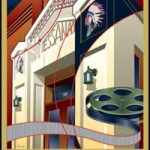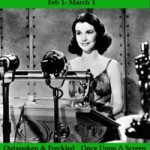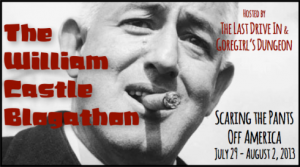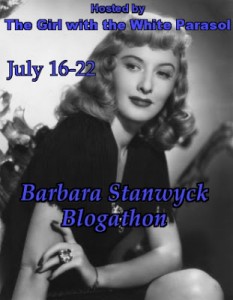Western RoundUp: Hour of the Gun (1967)
It’s been a few months since I devoted a Western RoundUp column to a single film, so this month I’ll focus on my first-ever viewing of Hour of the Gun (1967).

In doing so, I’m also returning to the topic of Wyatt Earp. I previously wrote about Earp on film for Classic Movie Hub in 2018, focusing in that column on Frontier Marshal (1939), Tombstone: The Town Too Tough to Die (1942), and Wichita (1955).
In Hour of the Gun Earp is played by a taciturn James Garner, with Jason Robards as Doc Holliday. I’ll note at the outset that in discussing the film I’ll be going into some detail, assuming many readers are familiar with the general outlines of the characters. Those seeking to avoid spoilers may wish to watch the film prior to reading this review.

Hour of the Gun was directed by John Sturges, who had previously directed another film on the Western legend, Gunfight at the O.K. Corral (1957). That film starred Burt Lancaster as Earp and Kirk Douglas as Doc. It’s still on my future Wyatt Earp viewing list along with Tombstone (1993) and Wyatt Earp (1994).
One of the unique things about Hour of the Gun is apparent as the opening credits begin: The movie begins, rather than ends, with the famed gunfight at the O.K. Corral.
I’ve only seen one other movie which “frontloads” the gunfight at or near the beginning, Dawn at Socorro (1954). The Socorro characters are not named Earp, Holliday, or Clanton, but they are very clearly based on them.

As also depicted in Tombstone: The Town Too Tough to Die, shortly after the O.K. Corral Morgan Earp (Sam Melville) is gunned down while playing billiards. The combined incidents of the O.K. Corral and Morgan’s death leave Earp and Ike Clanton (the great Robert Ryan) as mortal enemies, with Earp determined to hunt down Clanton and his gang by fair means or foul.
Earp is accompanied on his quest by the loyal Doc, whose ability with a gun belies the fact that he’s in failing health. One by one they track down members of Clanton’s gang, leading to a climactic confrontation with Clanton himself.

The script by Edward Anhalt conceives Earp in far different terms than the gentlemanly Earp of a Fonda, Scott, or McCrea; this Wyatt mostly (but not completely) stays within the confines of the law, but he’s frankly a rather mean man. Earp cares about his family and his friend Doc – though he and Doc try to hide it most of the time with brusque talk – but anger is the consuming emotion in his life.
It’s quite interesting to see Garner, so often identified with more lighthearted characters, in such a tightly wound role. There’s a stunning scene in the last half hour of the film where Earp shoots someone over and over and over yet again, long past the point of necessity, as he unleashes his rage.

At the movie’s end, though Earp assures the dying Doc he’ll take a prestigious law enforcement job in Arizona, he tells their friend Dr. Goodfellow (Karl Swenson) that he has no intention of doing so. As Earp rides away, a lonely future seems to stretch before him.
Although in some respects Garner’s performance is fairly one-note, at the same time he’s a good enough actor to be compelling. The viewer watches him closely, trying to infer what’s going on in his mind from his actions and especially the look in his eyes.

Robards is quite good as Doc, managing to avoid pathos despite Doc’s alcoholism and poor health. This Doc at times seems to be the voice of Earp’s conscience, particularly when Wyatt determines to follow Clanton into Mexico without a badge. Doc also provides what levity exists in the film; it’s interesting that Robards and Garner flip expectations in this regard.
Ryan has relatively little screen time, but all eyes are on him whenever he appears. He’s frankly terrifying, controlling a large gang of rough men with ease. His performance caused me to remember Spencer Tracy‘s comment when working with Ryan on Bad Day at Black Rock (1955): “He scares the hell out of me.” It’s remarkable acting from someone who offscreen was a quiet family man who co-founded a private elementary school.

Other pleasures of Hour of the Gun include William Windom in a small but entertaining role as a gambler who owes Doc money and is drafted to serve as a deputy, and a young Jon Voight as villainous Curly Bill Brocius, a role played in previous films by actors including Joe Sawyer and Edgar Buchanan.
The supporting cast also includes Steve Ihnat, William Schallert, Albert Salmi, Charles Aidman, Lonny Chapman, Larry Gates, Monte Markham, and Richard Bull, who like Karl Swenson was later a longtime regular on TV’s Little House on the Prairie.
As befitting a John Sturges film, there are some excellent action scenes, beginning with the gunfight which opens the movie; another particularly good sequence is a gunfight at a train station, choreographed in an exciting fashion.

While the depiction of gunfight deaths is relatively restrained in most of the movie, there are a couple of violent moments which tag the film as being made in the late ’60s, including a character taking a bullet in the forehead. It wasn’t more violence than I could handle, but it was definitely more than I expected.
The film feels slightly padded at 110 minutes, and I think it could have been shaved down closer to 90 without viewers missing anything of significance. A good example is a prolonged sequence of a woman, never seen again, waking up her husband in time for him to witness an attack on Virgil Earp (Frank Converse). A full minute probably could have been excised right there.

I was somewhat amused by a title card over the gunfight telling viewers “This picture is based on fact. This is the way it happened.” That statement can be taken with the proverbial grain of salt, for too many reasons to detail here.
The fine cinematography was by Lucien Ballard, with much of the movie filmed on location in Arizona and Mexico. The score was by the great Jerry Goldsmith.
Overall I felt Hour of the Gun, while not reaching greatness, was a solid, worthwhile entry in the cinematic history of Wyatt Earp.
…
– Laura Grieve for Classic Movie Hub
Laura can be found at her blog, Laura’s Miscellaneous Musings, where she’s been writing about movies since 2005, and on Twitter at @LaurasMiscMovie. A lifelong film fan, Laura loves the classics including Disney, Film Noir, Musicals, and Westerns. She regularly covers Southern California classic film festivals. Laura will scribe on all things western at the ‘Western RoundUp’ for CMH.






































































































